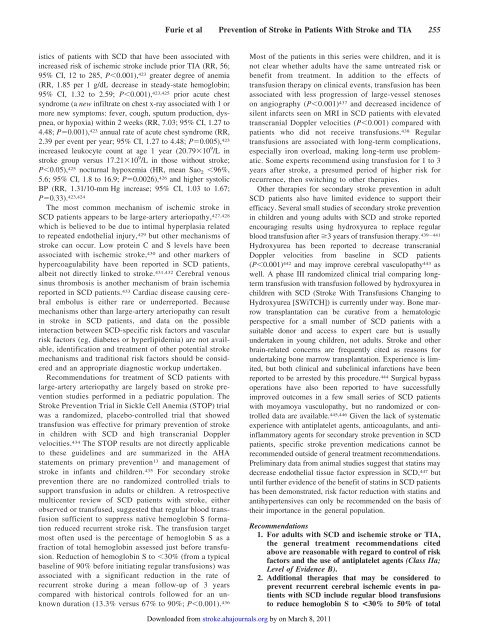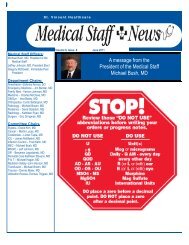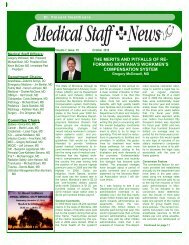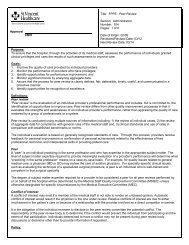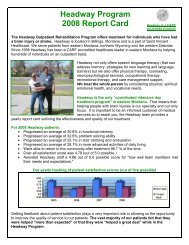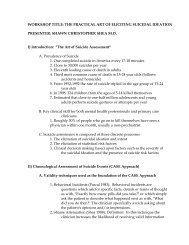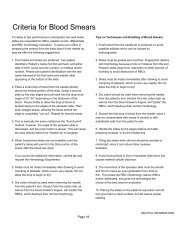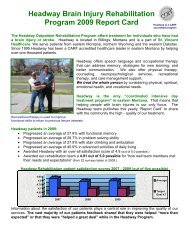AHA/ASA Guideline Guidelines for the Prevention of Stroke in ...
AHA/ASA Guideline Guidelines for the Prevention of Stroke in ...
AHA/ASA Guideline Guidelines for the Prevention of Stroke in ...
Create successful ePaper yourself
Turn your PDF publications into a flip-book with our unique Google optimized e-Paper software.
Furie et al <strong>Prevention</strong> <strong>of</strong> <strong>Stroke</strong> <strong>in</strong> Patients With <strong>Stroke</strong> and TIA 255istics <strong>of</strong> patients with SCD that have been associated with<strong>in</strong>creased risk <strong>of</strong> ischemic stroke <strong>in</strong>clude prior TIA (RR, 56;95% CI, 12 to 285, P0.001), 423 greater degree <strong>of</strong> anemia(RR, 1.85 per 1 g/dL decrease <strong>in</strong> steady-state hemoglob<strong>in</strong>;95% CI, 1.32 to 2.59; P0.001), 423,425 prior acute chestsyndrome (a new <strong>in</strong>filtrate on chest x-ray associated with 1 ormore new symptoms: fever, cough, sputum production, dyspnea,or hypoxia) with<strong>in</strong> 2 weeks (RR, 7.03; 95% CI, 1.27 to4.48; P0.001), 423 annual rate <strong>of</strong> acute chest syndrome (RR,2.39 per event per year; 95% CI, 1.27 to 4.48; P0.005), 423<strong>in</strong>creased leukocyte count at age 1 year (20.7910 9 /L <strong>in</strong>stroke group versus 17.2110 9 /L <strong>in</strong> those without stroke;P0.05), 425 nocturnal hypoxemia (HR, mean Sao 2 96%,5.6; 95% CI, 1.8 to 16.9; P0.0026), 426 and higher systolicBP (RR, 1.31/10-mm Hg <strong>in</strong>crease; 95% CI, 1.03 to 1.67;P0.33). 423,424The most common mechanism <strong>of</strong> ischemic stroke <strong>in</strong>SCD patients appears to be large-artery arteriopathy, 427,428which is believed to be due to <strong>in</strong>timal hyperplasia relatedto repeated endo<strong>the</strong>lial <strong>in</strong>jury, 429 but o<strong>the</strong>r mechanisms <strong>of</strong>stroke can occur. Low prote<strong>in</strong> C and S levels have beenassociated with ischemic stroke, 430 and o<strong>the</strong>r markers <strong>of</strong>hypercoagulability have been reported <strong>in</strong> SCD patients,albeit not directly l<strong>in</strong>ked to stroke. 431,432 Cerebral venouss<strong>in</strong>us thrombosis is ano<strong>the</strong>r mechanism <strong>of</strong> bra<strong>in</strong> ischemiareported <strong>in</strong> SCD patients. 433 Cardiac disease caus<strong>in</strong>g cerebralembolus is ei<strong>the</strong>r rare or underreported. Becausemechanisms o<strong>the</strong>r than large-artery arteriopathy can result<strong>in</strong> stroke <strong>in</strong> SCD patients, and data on <strong>the</strong> possible<strong>in</strong>teraction between SCD-specific risk factors and vascularrisk factors (eg, diabetes or hyperlipidemia) are not available,identification and treatment <strong>of</strong> o<strong>the</strong>r potential strokemechanisms and traditional risk factors should be consideredand an appropriate diagnostic workup undertaken.Recommendations <strong>for</strong> treatment <strong>of</strong> SCD patients withlarge-artery arteriopathy are largely based on stroke preventionstudies per<strong>for</strong>med <strong>in</strong> a pediatric population. The<strong>Stroke</strong> <strong>Prevention</strong> Trial <strong>in</strong> Sickle Cell Anemia (STOP) trialwas a randomized, placebo-controlled trial that showedtransfusion was effective <strong>for</strong> primary prevention <strong>of</strong> stroke<strong>in</strong> children with SCD and high transcranial Dopplervelocities. 434 The STOP results are not directly applicableto <strong>the</strong>se guidel<strong>in</strong>es and are summarized <strong>in</strong> <strong>the</strong> <strong>AHA</strong>statements on primary prevention 13 and management <strong>of</strong>stroke <strong>in</strong> <strong>in</strong>fants and children. 435 For secondary strokeprevention <strong>the</strong>re are no randomized controlled trials tosupport transfusion <strong>in</strong> adults or children. A retrospectivemulticenter review <strong>of</strong> SCD patients with stroke, ei<strong>the</strong>robserved or transfused, suggested that regular blood transfusionsufficient to suppress native hemoglob<strong>in</strong> S <strong>for</strong>mationreduced recurrent stroke risk. The transfusion targetmost <strong>of</strong>ten used is <strong>the</strong> percentage <strong>of</strong> hemoglob<strong>in</strong> S as afraction <strong>of</strong> total hemoglob<strong>in</strong> assessed just be<strong>for</strong>e transfusion.Reduction <strong>of</strong> hemoglob<strong>in</strong> S to 30% (from a typicalbasel<strong>in</strong>e <strong>of</strong> 90% be<strong>for</strong>e <strong>in</strong>itiat<strong>in</strong>g regular transfusions) wasassociated with a significant reduction <strong>in</strong> <strong>the</strong> rate <strong>of</strong>recurrent stroke dur<strong>in</strong>g a mean follow-up <strong>of</strong> 3 yearscompared with historical controls followed <strong>for</strong> an unknownduration (13.3% versus 67% to 90%; P0.001). 436Most <strong>of</strong> <strong>the</strong> patients <strong>in</strong> this series were children, and it isnot clear whe<strong>the</strong>r adults have <strong>the</strong> same untreated risk orbenefit from treatment. In addition to <strong>the</strong> effects <strong>of</strong>transfusion <strong>the</strong>rapy on cl<strong>in</strong>ical events, transfusion has beenassociated with less progression <strong>of</strong> large-vessel stenoseson angiography (P0.001) 437 and decreased <strong>in</strong>cidence <strong>of</strong>silent <strong>in</strong>farcts seen on MRI <strong>in</strong> SCD patients with elevatedtranscranial Doppler velocities (P0.001) compared withpatients who did not receive transfusions. 438 Regulartransfusions are associated with long-term complications,especially iron overload, mak<strong>in</strong>g long-term use problematic.Some experts recommend us<strong>in</strong>g transfusion <strong>for</strong> 1 to 3years after stroke, a presumed period <strong>of</strong> higher risk <strong>for</strong>recurrence, <strong>the</strong>n switch<strong>in</strong>g to o<strong>the</strong>r <strong>the</strong>rapies.O<strong>the</strong>r <strong>the</strong>rapies <strong>for</strong> secondary stroke prevention <strong>in</strong> adultSCD patients also have limited evidence to support <strong>the</strong>irefficacy. Several small studies <strong>of</strong> secondary stroke prevention<strong>in</strong> children and young adults with SCD and stroke reportedencourag<strong>in</strong>g results us<strong>in</strong>g hydroxyurea to replace regularblood transfusion after 3 years <strong>of</strong> transfusion <strong>the</strong>rapy. 439–441Hydroxyurea has been reported to decrease transcranialDoppler velocities from basel<strong>in</strong>e <strong>in</strong> SCD patients(P0.001) 442 and may improve cerebral vasculopathy 443 aswell. A phase III randomized cl<strong>in</strong>ical trial compar<strong>in</strong>g longtermtransfusion with transfusion followed by hydroxyurea <strong>in</strong>children with SCD (<strong>Stroke</strong> With Transfusions Chang<strong>in</strong>g toHydroxyurea [SWiTCH]) is currently under way. Bone marrowtransplantation can be curative from a hematologicperspective <strong>for</strong> a small number <strong>of</strong> SCD patients with asuitable donor and access to expert care but is usuallyundertaken <strong>in</strong> young children, not adults. <strong>Stroke</strong> and o<strong>the</strong>rbra<strong>in</strong>-related concerns are frequently cited as reasons <strong>for</strong>undertak<strong>in</strong>g bone marrow transplantation. Experience is limited,but both cl<strong>in</strong>ical and subcl<strong>in</strong>ical <strong>in</strong>farctions have beenreported to be arrested by this procedure. 444 Surgical bypassoperations have also been reported to have successfullyimproved outcomes <strong>in</strong> a few small series <strong>of</strong> SCD patientswith moyamoya vasculopathy, but no randomized or controlleddata are available. 445,446 Given <strong>the</strong> lack <strong>of</strong> systematicexperience with antiplatelet agents, anticoagulants, and anti<strong>in</strong>flammatoryagents <strong>for</strong> secondary stroke prevention <strong>in</strong> SCDpatients, specific stroke prevention medications cannot berecommended outside <strong>of</strong> general treatment recommendations.Prelim<strong>in</strong>ary data from animal studies suggest that stat<strong>in</strong>s maydecrease endo<strong>the</strong>lial tissue factor expression <strong>in</strong> SCD, 447 butuntil fur<strong>the</strong>r evidence <strong>of</strong> <strong>the</strong> benefit <strong>of</strong> stat<strong>in</strong>s <strong>in</strong> SCD patientshas been demonstrated, risk factor reduction with stat<strong>in</strong>s andantihypertensives can only be recommended on <strong>the</strong> basis <strong>of</strong><strong>the</strong>ir importance <strong>in</strong> <strong>the</strong> general population.Recommendations1. For adults with SCD and ischemic stroke or TIA,<strong>the</strong> general treatment recommendations citedabove are reasonable with regard to control <strong>of</strong> riskfactors and <strong>the</strong> use <strong>of</strong> antiplatelet agents (Class IIa;Level <strong>of</strong> Evidence B).2. Additional <strong>the</strong>rapies that may be considered toprevent recurrent cerebral ischemic events <strong>in</strong> patientswith SCD <strong>in</strong>clude regular blood transfusionsto reduce hemoglob<strong>in</strong> S to


